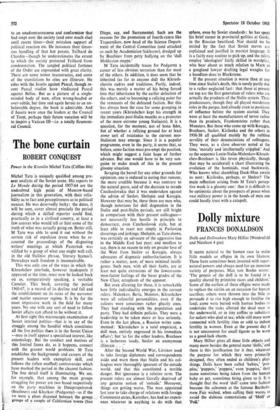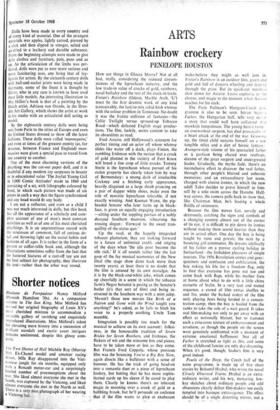Dolly mixture
FRANCES DONALDSON
It seems natural to the human race to make little models or effigies in its own likeness. These have sometimes been invested with super- natural powers and always used for an immense variety of purposes. Max von Boehn wrote: `The genesis of the doll is to be found in a quality shared by primitive races and children.' Some of the earliest of these effigies were made to replace the victim on an occasion for human sacrifice; others were thrown into the Nile to. persuade it to rise high enough to fertilise the land; some were buried with human bodies to undertake the tasks allotted the dead man in the underworld, or in tiny coffins to substitute for sailors who died at sea; while still more were connected with fertility rites or sold to induce fertility in women. Even at the present day it is not uncommon for small figures to be worn as a good-luck charm.
Mary Hillier gives all these little objects and many more besides the general name 'dolls,' and there is this justification for it that, whatever the purpose for which they were primarily designed, they often ended as children's play- things. Dolls have been called `babies,' pou- pees,' `puppets,' poppets,' even 'puppies,' their name sometimes being taken, from the human baby or pet, sometimes being given to it. It is thought that the word 'doll' came into fashion because the salesmen at the famous Bartholo- mew Fair wished, when calling their wares, to avoid the dubious connotations of 'Moll' or Dolls have been made in every country and of every kind of material. One of the strangest materials was apples, lightly carved, pierced by a stick and then dipped in vinegar, salted and air-dried to a leathery and durable substance. From the beginning attempts were made to give dolls clothes and furniture, pots, pans and so on. As the articulation of the limbs was per- fected, dolls were put to ever more various and more fascinating uses, one being that of lay- figures for artists. By the sixteenth century dolls with ball-and-socket joints were being made in Germany, some of the finest it is thought by Darer, who in any case is known to have used these little models. An interesting illustration to Mrs Hillier's book is that of a painting by the Dutch artist, Adriaen van Ostade, in the Dres- den Art Gallery, which shows the artist at work in his studio with an articulated doll acting as model.
By the eighteenth century dolls were being sent from Paris to the cities of Europe and even the United States dressed to show off the latest fashions. These dolls were called 'mannequins,' and even at times of the greatest enmity (as, for instance, between France and England) man- nequins were given a special pass to travel from one country to another.
One of the most charming versions of the plaything was the cut-out paper doll, and it is doubtful if any modern toy surpasses in beauty or in educational value 'The Joyful Young Girl in 1,000 Comic Attitudes' made in 1860 and consisting of a set, with lithographs coloured by hand, in which each picture was made of six pieces in such a way that the figure synchronised and any head would fit any body. -
I am not a collector, and even as a child I was not much interested in dolls, but this book has all the appearance of a scholarly and com- plete account of one of man's most constant activities as well as of one of his most cherished playthings. It is an unpretentious record with the minimum of comment, full of curious de- tail and throwing light on the social habits and fashions of all ages. It is rather in the form of a picture or coffee-table book and, although the illustrations sometimes suffer from the fact that the battered features of a cast-off toy are not the best subject for photography, they illustrate the text—rather than the other way round.







































 Previous page
Previous page